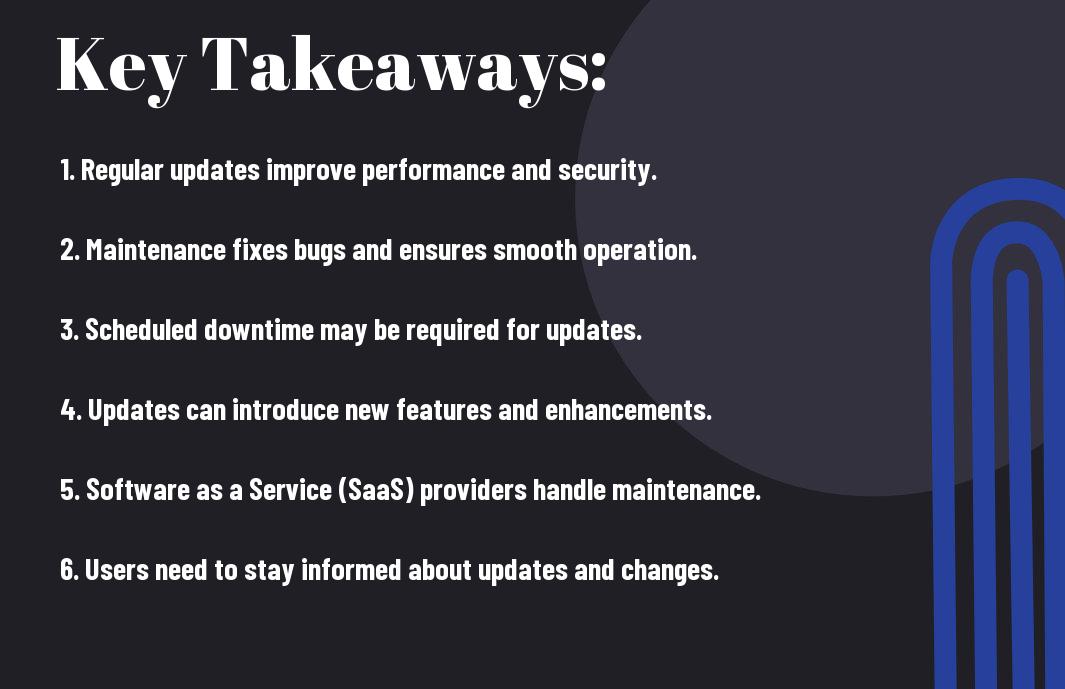With the ever-evolving landscape of technology, understanding how updates and maintenance function with software services is vital for optimal performance. In this guide, you will unravel the intricacies of software updates, from bug fixes to feature enhancements, and learn how regular maintenance ensures the smooth operation and security of your digital tools. Let’s probe into the world of software upkeep and discover how it can benefit you and your digital experience.
Key Takeaways:
- Regular Updates: Regular updates are crucial for software services as they help in fixing bugs, improving performance, and enhancing security.
- Continuous Maintenance: Maintenance is an ongoing process for software services that involves monitoring, troubleshooting, and optimizing the system to ensure smooth operation.
- Importance of Timely Updates: Timely updates and maintenance help in ensuring that software services are running efficiently, minimizing downtime, and keeping up with evolving technology trends.

The Importance of Updates
Why Regular Updates Matter
While it may seem like a hassle to constantly update the software services you use, regular updates are crucial for several reasons. Firstly, updates often include bug fixes and security patches that help protect your data from cyber threats. By staying up to date, you are less likely to fall victim to malware or hacking attempts that target vulnerabilities in older versions of the software.
Additionally, updates frequently introduce new features and improvements that can enhance your user experience. From increased efficiency to enhanced functionality, staying current with updates ensures you are getting the most out of the software service you are using.
Consequences of Neglecting Updates
Forgetting or ignoring software updates can have serious consequences. Outdated software is more vulnerable to cyber attacks, as hackers often exploit known security flaws in older versions. By neglecting updates, you are importantly leaving your system exposed to potential threats, putting your sensitive information at risk.
Neglecting updates can also lead to compatibility issues with other software or services. As technology evolves, older versions of software may not work well with newer programs, causing glitches or malfunctions. This can disrupt your workflow and cause frustration as you try to troubleshoot issues that could have been avoided with timely updates.

Types of Updates
If you’re curious about the different types of updates that software services undergo, here is a breakdown for you:
| Security Patches | Feature Enhancements |
| Bug Fixes | Enhancements |
Security Patches
For security patches, these updates are crucial for protecting your software from potential vulnerabilities. They are designed to address specific security risks that have been identified by developers. Installing security patches promptly is vital to keep your software safe from cyber threats.
Feature Enhancements
Types of updates involve feature enhancements that introduce new functionalities, improve user experience, or add new capabilities to the software. These updates often aim to make the software more efficient, user-friendly, and competitive in the market. Embracing feature enhancements can help you maximize the benefits of the software and stay up-to-date with the latest trends in technology.
Bug Fixes
Fixes for bugs are updates that target and eliminate software issues, glitches, or malfunctions that may affect the performance or user experience. Bug fixes are crucial for ensuring that the software runs smoothly and without any disruptions. By regularly updating your software with bug fixes, you can enjoy a more stable and reliable performance.
Maintenance Strategies
Scheduled Maintenance
To ensure the smooth running of software services, scheduled maintenance is important. During these planned maintenance periods, updates and system checks are performed to keep everything running optimally. By scheduling maintenance during off-peak hours, you minimize disruption to your work and ensure that the updates are applied seamlessly.
On-Demand Maintenance
Sometimes issues can arise unexpectedly, and that’s when on-demand maintenance comes into play. If a problem crops up that needs immediate attention, you can request on-demand maintenance to address the issue promptly. This type of maintenance is reactive and is particularly useful for urgent situations that cannot wait until the next scheduled maintenance window.
On-demand maintenance allows you to address critical issues swiftly, ensuring minimal downtime for your software services. It gives you the flexibility to tackle unexpected issues as soon as they arise, keeping your systems up and running smoothly.
Automated Maintenance
On the other hand, automated maintenance takes a proactive approach to keeping your software services up to date and functioning well. With automated maintenance processes in place, tasks such as regular backups, security updates, and performance optimizations can be scheduled to run automatically without manual intervention. This helps in maintaining the health and efficiency of your software services without constant monitoring.
Automated maintenance streamlines routine tasks, freeing up your time to focus on other critical aspects of your work. By automating repetitive maintenance tasks, you can ensure that your software services are consistently optimized and secure, with minimal effort on your part.

Update Deployment Methods
Once again, update deployment methods play a crucial role in ensuring that your software services are up to date and functioning at their best. There are different approaches to deploying updates, each with its advantages and considerations.
Manual Updates
Manual updates involve you or your team manually applying updates to your software system. While this method gives you more control over when and how updates are deployed, it can be time-consuming and prone to human error. You need to ensure that updates are applied uniformly across all systems to avoid compatibility issues or security vulnerabilities.
Automatic Updates
To streamline the update process, automatic updates involve setting up your software system to apply updates automatically when they become available. This method ensures that your software is always up to date without requiring manual intervention. Automatic updates help in keeping your system secure and optimized with the latest features and bug fixes.
With automatic updates, you have the peace of mind that your software is continually being maintained without needing to allocate resources for manual update deployments. However, you need to carefully manage automatic updates to prevent unexpected disruptions to your system or compatibility issues with other software.
Hybrid Approach
With a hybrid approach, you can combine the benefits of manual and automatic updates. This method allows you to have control over critical updates while automating less critical ones. By carefully selecting which updates are automated and which require manual intervention, you can optimize the update process based on your specific needs and priorities.
This approach provides flexibility and customization in managing updates, ensuring that your software services are always up to date and operating efficiently. It gives you the ability to balance control and automation effectively within your maintenance strategy.
Challenges in Update and Maintenance
Now, when it comes to updates and maintenance of software services, there are several challenges that you may encounter along the way. One significant aspect is balancing the frequency of updates with the disruption they may cause to your system. It’s crucial to keep your software up-to-date to ensure security, performance, and bug fixes. However, too frequent updates can interrupt your workflow and cause downtime. To probe deeper into this topic, you can check out A Software Maintenance Guide for 2024: Importance ….
Balancing Frequency and Disruption
One challenge you might face is finding the right balance between how often you update your software and how much disruption it causes. While frequent updates are necessary for security and performance reasons, they can also disrupt your workflow. You need to carefully plan and schedule updates to minimize downtime and ensure smooth operation.
Managing User Expectations
Update: Another challenge is managing user expectations when it comes to software updates and maintenance. Users often expect seamless updates without any disruptions to their daily tasks. However, in reality, updates can sometimes cause temporary inconveniences or changes in the user interface. It’s important to communicate proactively with your users about upcoming updates, their benefits, and any potential disruptions they may experience.
Plus, it’s vital to provide clear instructions on how users can prepare for updates, such as saving their work, backing up data, or adjusting their schedules. By managing user expectations effectively, you can help minimize frustration and build trust with your users.
Ensuring Compatibility
Maintenance: Ensuring compatibility is another significant challenge when it comes to software updates and maintenance. As software evolves, there can be compatibility issues with existing systems, hardware, or third-party integrations. It’s crucial to test updates thoroughly in different environments to ensure that they work seamlessly across all platforms. By proactively addressing compatibility issues, you can prevent potential disruptions and ensure a smooth user experience.
Managing: In managing compatibility challenges, you should establish clear protocols for testing updates, collaborate with stakeholders to identify potential compatibility issues, and provide support for users experiencing any compatibility issues. By staying proactive and responsive, you can mitigate compatibility challenges and maintain the overall performance of your software services.
Best Practices for Effective Updates
Clear Communication
Updates to software services are crucial to keep everything running smoothly. Clear communication is key to ensuring that users understand why updates are necessary and what changes they can expect. Before implementing an update, make sure to inform your users through various channels such as emails, in-app notifications, or blog posts. Clearly outline the benefits of the update, any new features or improvements, and any actions users might need to take.
Thorough Testing
Practices for thorough testing before deploying updates are crucial to prevent any unexpected issues or bugs. This involves testing the update in various environments to ensure compatibility and stability. Automated testing tools can help streamline this process, but manual testing by your team is also crucial to catch any potential issues that automated tools might miss. Thorough testing helps minimize the risk of disruptions once the update is live.
It’s imperative to remember not to rush through the testing phase, as even small oversights can lead to significant problems for your users. Taking the time to test updates thoroughly can save you from dealing with larger issues down the line.
Conclusion
Drawing together all the information we’ve covered, you now have a better understanding of how updates and maintenance work with software services. Regular updates are crucial to ensure your software remains secure, bug-free, and compatible with new technologies. By staying on top of updates, you can benefit from improved performance and new features that enhance your overall user experience. Additionally, software maintenance plays a vital role in keeping your system running smoothly by fixing bugs, resolving compatibility issues, and optimizing performance.
If you’re curious to learn more about the intricacies of software maintenance, you can explore this Reddit discussion on what is the difference between software maintenance and software development. Keep in mind, by investing time and effort into updates and maintenance, you can ensure your software remains reliable, secure, and efficient for years to come.
FAQ
Q: How often do software services receive updates and maintenance?
A: Software services typically receive updates and maintenance on a regular basis. The frequency can vary depending on the provider and the nature of the service. Some services may have weekly or monthly updates, while others may have less frequent updates. Maintenance is usually scheduled based on the urgency of the need and the impact on users.
Q: How are updates and maintenance typically communicated to users?
A: Updates and maintenance schedules are usually communicated to users through various channels such as email notifications, in-app notifications, blog posts, or announcements on the provider’s website. Some software services also have a dedicated status page where users can check the current status of the service and upcoming maintenance windows.
Q: What should users do to ensure a smooth update and maintenance process?
A: To ensure a smooth update and maintenance process, users should stay informed about upcoming updates and maintenance schedules. It is important to follow any instructions or guidelines provided by the service provider, such as backing up data, logging out of the service during maintenance windows, or updating any client software. Being proactive and reporting any issues or bugs encountered after an update can also help improve the overall user experience.


